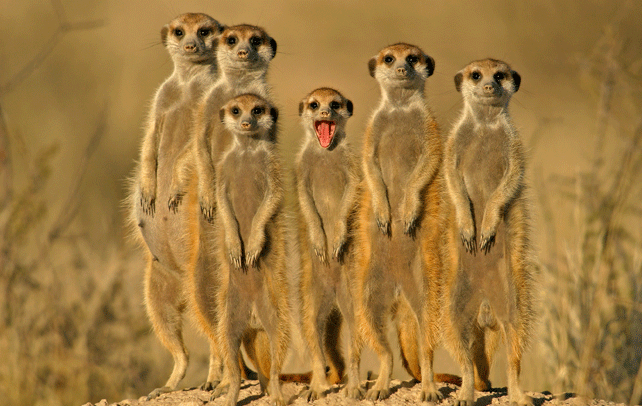Cool Facts About Meerkat

An animated film produced by the BBC presented the daily struggles of a family of meerkats in the Kalahari Desert. Do you know which movie it was? The Meerkats! The movie beautifully describes the day-to-day battle of a meerkat’s life. Meerkats are the brown furry animals found in the burrows of African desert. Although they belong to the same family as that of mongoose, they have no familiarity to mongoose. Unlike mongoose, they love to live in a group and can have as many as 30 members in the group. Tail is one of the interesting features of a meerkat and they are also known as slender-tailed meerkats. Their tails act as a tripod and make them stand like a human, thus cheating the predators. Although they trick the predators, they are the honest ones when it comes to serving their gang leader. They are so selfless animals that they work as a subservient to the gang leader all their lives and don’t even bear their own children. Go ahead and read some more interesting and amazing facts about these desert animals.
Fast Facts
Scientific Name: Suricata suricatta
Kingdom: Animalia
Phylum: Chordata
Class: Mammalia
Order: Carnivora
Family: Herpestidae
Species: S. suricatta
Diet: Insects, Lizards, Snake, scorpions, spiders, plants, eggs of small animals
Size: 25 to 35cm
Tail Length: 17 to 25 cm
Weight: 720 to 731 grams
Life Span: 12 to 14 years
Natural Habitat: Kalahari Desert inBotswana andSouth Africa
Call: Chirp, trill, growl, bark
Gestation Period: Approximately11 weeks
Number of Offspring: 1 to 5 pups
Interesting And Fun Facts About Meerkat
- Meerkats are the only species of the genus suricatta.
- Depending on the region, the basic colours of meerkat can vary from grey to tan to silver tint. They also have dark brown or black horizontal stripes on their back with a reddish undercoat.
- A group of meerkats is known as mob or gang which consists of five to thirty members, thus making them the highly social creatures.
- You can’t make a pet of them as they are very possessive and will mark their owner with urine or bite any stranger.
- They share their burrows with yellow mongoose, ground squirrels, and sometimes with snakes.
- These diurnal animals forage during the daytime and sleep at night.
- Their belly acts like a solar panel that absorbs heat and keeps them warm.
- Consumption of poisonous creatures cannot harm their body and digestive system as million years of development has made them immune to poison. They are known for their bold and flamboyant diet and can eat any venomous animal ranging from cobras to scorpions.
- The tail of a meerkat can be seven to ten inches long, which is usually yellow in colour with black tip. Its tail is not bushy like the tail of mongoose rather it is slim. When excited, they hold their tail high and vertical.
- Interestingly, the breeding is done by alpha male and their female counterpart while the subordinates guard the children. These guards protect the whole gang when others are sleeping and eating. For them, the upkeep of the children of alpha is on high priority.
- Meerkats become fully grown within six months of their birth. Every meerkat has a crucial duty to perform. Some take care of the pups, some collect food, and others keep the danger at bay.
- Some subordinate meerkats even give instructions to children on how to kill a venomous prey like snakes and scorpions.
- Meerkats are also known for their altruistic behaviour. The lactating females feed the pups of alpha female with their own milk.
- If any subordinate gives birth to a pup then the pup is killed there and then, and the offending couple may be killed or kicked out of the gang. Often these couples form another group, but the process again starts with another alpha male and their female counterpart.
- They have an extraordinary power of judging whether someone has had pups in secret or not.
- Their multileveled burrows can have several chambers and as many as 15 entrances and exits. During daytime, meerkats reach the topmost level to stretch out in the sun while at night, they move deeper to shield themselves.
- Meekats have extremely developed smell, vision, and hearing senses to identify the predators. Alarming sound or call made by any of the meerkat warns others about the prospective enemy.
- The crescent shape of their ears helps closing the ears while digging burrows in order to prevent sand from getting inside their ears.
- They can recognize as much as 10 calls and can even differentiate between the different calls made for preys and predators.
- The eyes of meerkats are surrounded by inbuilt sunglasses that deflect rays of scorching sun from their eyes. They are far-sighted but their near-eyesight is poor.
- The curved incisors and high pointed cheek teeth help them in rasping food, like caterpillars, moths, butterflies, and others.
- Their legs and tail together make them stand tall so that they can get a full view of potential enemy hiding behind the long, dry grasses.
- With their medium sized snout, they can whiff a bug buried deep in the sand. They scent-mark the members of their mob to ward off the members of rival gang.
- Their very long, non-retractable, and shovel shaped claws help in excavating burrows and overturning rocks to take out insects.
- Everyday, they can dig up to several hundred times more than their body weight.
- Their burrows are as deep as 10 feet and they can dig even more deep to distract their attackers.
- Belonging to the lowest level of food chain, these animals have many predators like foxes, eagles, and other carnivores.









